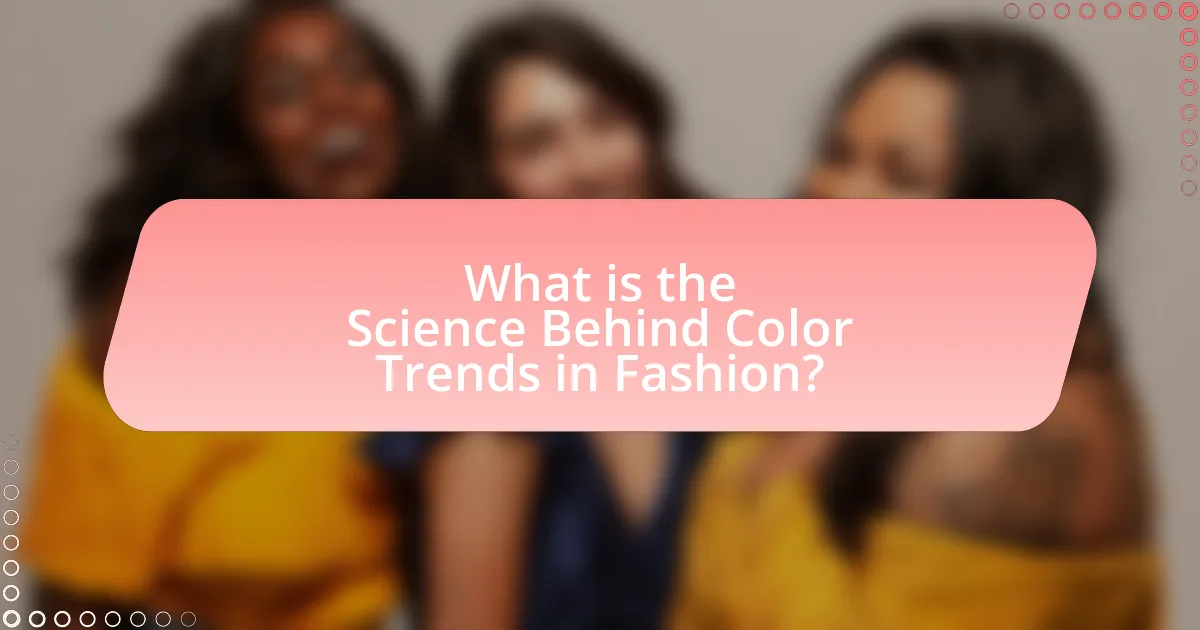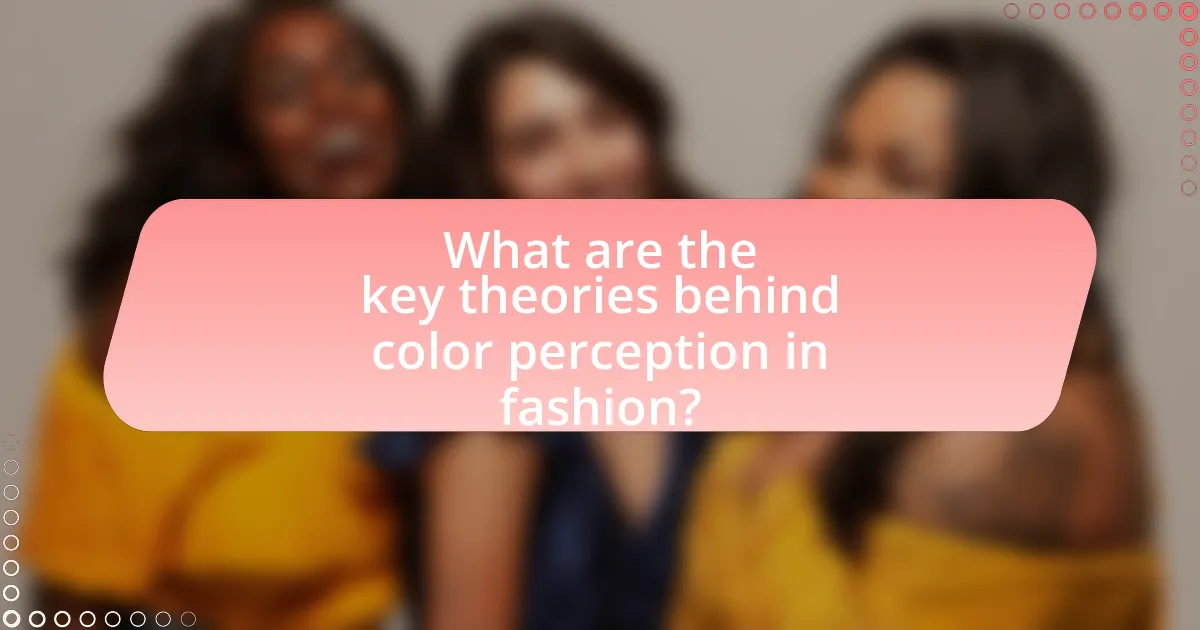The article explores the science behind color trends in fashion, examining the interplay of psychology, cultural influences, and market dynamics. It highlights how colors evoke specific emotions and associations, shaping consumer preferences and purchasing behavior. The role of fashion designers in setting trends, the impact of social and economic factors, and the application of color theory in design are also discussed. Additionally, the article addresses the influence of technology and social media on color trends, providing insights into effective strategies for brands to leverage these trends in marketing and design.

What is the Science Behind Color Trends in Fashion?
The science behind color trends in fashion is rooted in psychology, cultural influences, and market dynamics. Psychological studies indicate that colors evoke specific emotions and associations; for example, blue often conveys calmness, while red can signify passion or urgency. Cultural factors also play a significant role, as colors can have different meanings across various societies, influencing consumer preferences. Additionally, market dynamics, including seasonal changes and economic conditions, affect color trends; for instance, during economic downturns, consumers may gravitate towards more muted colors, while vibrant hues may dominate during prosperous times. Research by the Pantone Color Institute demonstrates that color forecasting is a systematic process, analyzing social trends, art, and technology to predict which colors will resonate with consumers in upcoming seasons.
How do color trends influence fashion choices?
Color trends significantly influence fashion choices by dictating the hues that dominate collections and consumer preferences each season. Designers often analyze color forecasts from organizations like Pantone, which annually identifies trending colors based on cultural, social, and economic factors. For instance, the Pantone Color of the Year can shape the palettes used in clothing, accessories, and even home decor, leading to widespread adoption among consumers and retailers. This influence is evident in sales data, where items in trending colors often see increased demand, demonstrating that color trends can drive purchasing behavior and shape overall fashion aesthetics.
What psychological effects do colors have on consumers?
Colors significantly influence consumer behavior by evoking specific emotions and perceptions. For instance, red can stimulate excitement and urgency, often used in clearance sales, while blue tends to create a sense of trust and calmness, making it popular among financial institutions. Research by the Institute for Color Research indicates that color can increase brand recognition by up to 80%, demonstrating its impact on consumer decision-making. Additionally, a study published in the Journal of Business Research found that colors can affect purchasing intentions, with warm colors like orange and yellow encouraging impulse buys, while cooler colors promote a more thoughtful purchasing process.
How do cultural factors shape color preferences in fashion?
Cultural factors significantly shape color preferences in fashion by influencing perceptions and associations tied to specific colors. For instance, in Western cultures, black is often associated with elegance and formality, while in some Eastern cultures, it may symbolize mourning. Additionally, colors like red are viewed as symbols of luck and prosperity in Chinese culture, leading to its popularity in festive attire. Research indicates that cultural context can dictate emotional responses to colors, as seen in studies by researchers such as Andrew Elliot and Markus Maier, who found that cultural background affects color perception and preference. Thus, cultural influences play a crucial role in determining which colors are favored in fashion across different societies.
Why do color trends change over time?
Color trends change over time due to a combination of cultural shifts, technological advancements, and psychological influences. Cultural events, such as social movements or economic changes, often inspire new color palettes that reflect the prevailing sentiments of society. For instance, the rise of environmental awareness has led to an increase in the popularity of earthy tones. Technological advancements in dyeing and fabric production also enable designers to experiment with new colors and finishes, making previously unavailable shades accessible. Additionally, psychological factors, such as the emotional responses colors evoke, influence consumer preferences, leading to shifts in trends. For example, studies show that colors like blue are often associated with calmness, which can drive their popularity during stressful times.
What role do fashion designers play in setting color trends?
Fashion designers play a crucial role in setting color trends by influencing consumer preferences and industry standards through their collections. Designers often showcase their color choices during fashion weeks and in seasonal collections, which are widely covered by media and adopted by retailers. For instance, Pantone, a leading color authority, collaborates with designers to forecast color trends, demonstrating how designer selections can shape broader market trends. This influence is evident in the cyclical nature of fashion, where colors introduced by prominent designers often become mainstream within a year, as seen with the rise of pastels in spring collections.
How do social and economic factors impact color trends?
Social and economic factors significantly influence color trends by shaping consumer preferences and market dynamics. For instance, during economic downturns, consumers often gravitate towards muted and neutral colors, reflecting a desire for stability and practicality, as seen in the 2008 financial crisis when fashion brands reported a rise in sales of subdued tones. Conversely, in times of economic prosperity, vibrant and bold colors tend to dominate, as consumers feel more confident and willing to experiment with their style. Additionally, social movements, such as the push for sustainability, have led to increased popularity of earthy tones and natural dyes, aligning with consumer values around environmental consciousness. This correlation between societal attitudes and economic conditions illustrates how color trends are not merely aesthetic choices but are deeply intertwined with the broader socio-economic landscape.

What are the key theories behind color perception in fashion?
The key theories behind color perception in fashion include the Color Theory, the Psychological Effects of Color, and the Cultural Context of Color. Color Theory, developed by artists and scientists, explains how colors interact and influence each other, impacting design choices in fashion. The Psychological Effects of Color suggest that different colors evoke specific emotions and associations; for example, blue is often linked to calmness, while red can signify passion. Cultural Context of Color emphasizes that color meanings can vary significantly across different cultures, affecting consumer preferences and trends. These theories collectively inform how designers select colors to resonate with their target audience and create desired emotional responses.
How does color theory apply to fashion design?
Color theory applies to fashion design by guiding designers in selecting and combining colors to create visually appealing and emotionally resonant garments. This theory encompasses concepts such as the color wheel, color harmony, and the psychological effects of colors, which help designers understand how colors interact and influence consumer perceptions. For instance, complementary colors can create striking contrasts that attract attention, while analogous colors can evoke a sense of harmony and calm. Research indicates that colors can significantly affect mood and behavior; for example, studies show that red can stimulate excitement, while blue tends to promote tranquility. Thus, understanding color theory enables fashion designers to make informed choices that enhance the aesthetic and emotional impact of their collections.
What are the primary color models used in fashion?
The primary color models used in fashion are the RGB (Red, Green, Blue), CMYK (Cyan, Magenta, Yellow, Black), and HSL (Hue, Saturation, Lightness) models. RGB is primarily used for digital applications, as it combines red, green, and blue light to create colors on screens. CMYK is utilized in print media, where cyan, magenta, yellow, and black inks are mixed to produce a wide range of colors. HSL is often employed in design software for its intuitive representation of colors based on human perception, allowing designers to adjust hue, saturation, and lightness easily. These models are foundational in ensuring accurate color representation across various fashion mediums.
How do complementary and analogous colors affect fashion aesthetics?
Complementary and analogous colors significantly influence fashion aesthetics by creating visual harmony and contrast. Complementary colors, which are opposite each other on the color wheel, enhance each other’s intensity, making outfits more striking and attention-grabbing. For example, a combination of blue and orange can create a vibrant look that stands out. Conversely, analogous colors, which are next to each other on the color wheel, provide a more subtle and cohesive appearance, promoting a sense of tranquility and sophistication. An outfit featuring shades of green, blue, and teal exemplifies this harmonious effect. Research in color theory, such as the work by Johannes Itten, highlights how these color relationships can evoke specific emotional responses and influence consumer behavior in fashion, thereby shaping trends and personal style choices.
What is the impact of technology on color trends in fashion?
Technology significantly influences color trends in fashion by enabling rapid analysis and dissemination of color data. Digital tools, such as color-matching software and trend forecasting platforms, allow designers to access real-time insights into consumer preferences and market demands. For instance, Pantone’s Color of the Year, which is determined using data analytics and social media trends, showcases how technology shapes color choices in the industry. Additionally, advancements in dyeing technology and sustainable materials have expanded the palette available to designers, allowing for innovative color applications that align with contemporary values. This integration of technology not only streamlines the design process but also enhances the ability to predict and respond to shifting color trends effectively.
How do digital tools influence color selection in fashion design?
Digital tools significantly influence color selection in fashion design by providing designers with advanced capabilities for color visualization, analysis, and trend forecasting. These tools, such as color-matching software and digital palettes, allow designers to experiment with various color combinations quickly and efficiently, enhancing creativity and precision in their work. For instance, software like Adobe Color enables designers to create and share color schemes, facilitating collaboration and inspiration. Additionally, data analytics tools can analyze consumer preferences and market trends, guiding designers in selecting colors that resonate with target audiences. This integration of technology in the design process not only streamlines workflows but also ensures that color choices are informed by real-time data and visual experimentation.
What role does social media play in promoting color trends?
Social media significantly influences the promotion of color trends by providing a platform for rapid dissemination and visual engagement. Platforms like Instagram and Pinterest allow users to share images and ideas, creating a viral effect that can elevate specific colors to trend status. For instance, the rise of the “Millennial Pink” trend can be attributed to its widespread visibility on social media, where influencers and brands showcased the color in various contexts, leading to its adoption across fashion and design industries. Additionally, analytics from social media platforms indicate that posts featuring trending colors receive higher engagement rates, further validating their role in shaping consumer preferences and driving market trends.

How can understanding color trends enhance fashion marketing?
Understanding color trends enhances fashion marketing by allowing brands to align their products with consumer preferences, thereby increasing sales and brand loyalty. Research indicates that colors can evoke specific emotions and influence purchasing decisions; for instance, a study by the Institute for Color Research found that up to 90% of snap judgments made about products can be based on color alone. By analyzing current color trends, fashion marketers can create collections that resonate with target audiences, ensuring that their offerings are not only visually appealing but also culturally relevant. This strategic alignment with color trends can lead to improved market positioning and competitive advantage in the fashion industry.
What strategies can brands use to leverage color trends?
Brands can leverage color trends by integrating them into their product designs, marketing campaigns, and visual branding. By analyzing color forecasts from industry experts like Pantone and observing consumer behavior, brands can identify emerging color palettes that resonate with their target audience. For instance, a study by the Color Marketing Group indicates that colors influence purchasing decisions, with 85% of consumers citing color as a primary reason for their choice. Additionally, brands can utilize social media platforms to gauge real-time color preferences and adapt their offerings accordingly, ensuring alignment with current trends. This strategic approach not only enhances brand relevance but also fosters consumer engagement and loyalty.
How can brands predict upcoming color trends effectively?
Brands can predict upcoming color trends effectively by analyzing consumer behavior, leveraging data analytics, and monitoring cultural influences. By utilizing tools like social media analytics, brands can track popular colors and styles that resonate with their target audience. For instance, Pantone, a leading color authority, conducts extensive research and surveys to identify emerging trends, which informs their annual Color of the Year selection. Additionally, historical data shows that color trends often correlate with societal events, economic conditions, and technological advancements, allowing brands to anticipate shifts in consumer preferences. This methodical approach ensures that brands remain relevant and aligned with market demands.
What are the best practices for incorporating color trends into marketing campaigns?
The best practices for incorporating color trends into marketing campaigns include aligning color choices with brand identity, analyzing target audience preferences, and utilizing current color trend forecasts. Brands should ensure that the colors used resonate with their established image, as consistent color usage can enhance brand recognition by up to 80%. Additionally, understanding the psychological impact of colors on consumer behavior is crucial; for instance, blue often conveys trust, while red can evoke urgency. Utilizing resources like the Pantone Color Institute’s annual color trend reports can provide valuable insights into emerging color trends, helping brands stay relevant and appealing to their audience.
What practical tips can fashion professionals use regarding color trends?
Fashion professionals can effectively utilize color trends by staying informed about seasonal palettes and consumer preferences. Regularly consulting resources like Pantone’s Color of the Year and fashion forecasting services, such as WGSN, provides insights into emerging color trends that resonate with target audiences. Additionally, analyzing past collections and market data reveals patterns in color popularity, enabling professionals to make informed decisions. For instance, a study by the Color Marketing Group indicates that colors like blue and green have consistently been favored in various markets, highlighting their potential for commercial success. By integrating these strategies, fashion professionals can align their designs with current trends and consumer expectations.
How can designers choose colors that resonate with their target audience?
Designers can choose colors that resonate with their target audience by conducting thorough research on the audience’s preferences, cultural associations, and psychological responses to colors. Understanding demographics, such as age, gender, and cultural background, allows designers to select colors that align with the audience’s values and emotions. For instance, studies show that blue is often associated with trust and dependability, making it a popular choice in corporate branding. Additionally, utilizing color psychology, which indicates that colors can evoke specific feelings—like red for excitement or green for tranquility—enables designers to create a more impactful connection with their audience. By analyzing market trends and consumer behavior, designers can also identify which colors are currently favored within their target demographic, ensuring their choices are relevant and appealing.
What are common pitfalls to avoid when working with color trends in fashion?
Common pitfalls to avoid when working with color trends in fashion include neglecting the target audience’s preferences, failing to consider seasonal variations, and overlooking the psychological impact of colors. Designers often make the mistake of choosing colors based solely on personal taste rather than aligning with consumer expectations, which can lead to poor sales. Additionally, ignoring seasonal trends can result in collections that feel outdated or irrelevant; for instance, bright colors may be more suitable for spring and summer, while darker tones are preferred in fall and winter. Lastly, the psychological effects of colors, such as how blue can evoke calmness and red can signify urgency, should be factored into design choices to effectively communicate the intended message and resonate with consumers.


